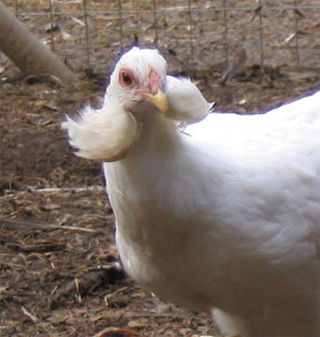
The Araucana is a breed of domestic chicken from Chile. Its name derives from the Araucanía region of Chile where it is believed to have originated. It lays blue-shelled eggs, one of very few breeds that do so.
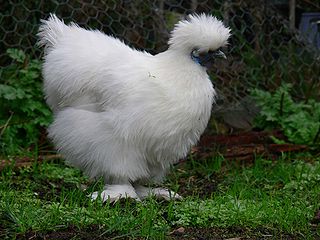
The Silkie is a breed of chicken named for its atypically fluffy plumage, which is said to feel like silk and satin. The breed has several other unusual qualities, such as black skin and bones, blue earlobes, and five toes on each foot, whereas most chickens have only four. They are often exhibited in poultry shows, and also appear in various colors. In addition to their distinctive physical characteristics, Silkies are well known for their calm and friendly temperament. It is among the most docile of poultry. Hens are also exceptionally broody, and care for young well. Although they are fair layers themselves, laying only about three eggs a week, they are commonly used to hatch eggs from other breeds and bird species due to their broody nature. Silkie chickens have been bred to have a wide variety of colors which include but are not limited to: Black, Blue, Buff, Partridge, Splash, White, Lavender, Paint and Porcelain.
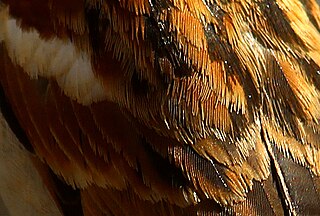
Plumage is a layer of feathers that covers a bird and the pattern, colour, and arrangement of those feathers. The pattern and colours of plumage differ between species and subspecies and may vary with age classes. Within species, there can be different colour morphs. The placement of feathers on a bird is not haphazard but rather emerges in organized, overlapping rows and groups, and these feather tracts are known by standardized names.

The Japanese Bantam or Chabo is a Japanese breed of ornamental chicken. It is a true bantam breed, meaning that it has no large fowl counterpart. It characterised by very short legs and a large upright tail that reaches much higher than the head of the bird.

The Orpington or Buff Orpington Duck is a breed of domestic duck. It is a dual-purpose breed used for meat and egg production. It is capable of laying up to 220 eggs a year. Originally created by William Cook of Orpington, Kent, England, from the selection of mis-marked Blue Orpington Ducks; Cook was also the developer of the Orpington chicken. The breeds used in the development of the breed included Cayuga, Indian Runner, commercial Aylesbury and Rouen. It is proposed that Cook's intentions for the breed were to capitalize on the growing demand for the buff colour pattern. The Buff Orpington Duck was introduced to the public at the Dairy Show, the Agricultural Hall (q.v.), Islington, London in October 1897. It is considered a threatened breed by the ALBC. This breed was admitted to the British Poultry Standard in 1910 and the American Poultry Associations Standard of Perfection as the 'Buff Duck' in the Medium class in 1914. The Orpington duck is available in three colour varieties: Buff, Blond and Brown. The Buff Orpington is an unstable colour due to a blue dilution gene which means that from the offspring, all three colour variations will appear.

Flight feathers are the long, stiff, asymmetrically shaped, but symmetrically paired pennaceous feathers on the wings or tail of a bird; those on the wings are called remiges, singular remex, while those on the tail are called rectrices, singular rectrix. The primary function of the flight feathers is to aid in the generation of both thrust and lift, thereby enabling flight. The flight feathers of some birds perform additional functions, generally associated with territorial displays, courtship rituals or feeding methods. In some species, these feathers have developed into long showy plumes used in visual courtship displays, while in others they create a sound during display flights. Tiny serrations on the leading edge of their remiges help owls to fly silently, while the extra-stiff rectrices of woodpeckers help them to brace against tree trunks as they hammer on them. Even flightless birds still retain flight feathers, though sometimes in radically modified forms.

The Sebright is a British breed of bantam chicken. It is a true bantam – a miniature bird with no corresponding large version – and is one of the oldest recorded British bantam breeds. It is named after Sir John Saunders Sebright, who created it as an ornamental breed by selective breeding in the early nineteenth century.

The Naked Neck is a breed of chicken that is naturally devoid of feathers on its neck and vent. The breed is also called the Transylvanian Naked Neck, as well as the Turken. The name "Turken" arose from the mistaken idea that the bird was a hybrid of a chicken and the domestic turkey. Naked Necks are fairly common in Europe today, but are rare in North America and very common in South America. The trait for a naked neck is a dominant one controlled by one gene and is fairly easy to introduce into other breeds, however these are hybrids rather than true Naked Necks, which is a breed recognized by the American Poultry Association since 1965, it was introduced in Britain in the 1920s. There are other breeds of naked necked chicken, such as the French naked neck, which is often confused with the Transylvanian, and the naked necked gamefowl.

The Campine is a breed of domestic chicken originating in the northern part of Belgium. It is named for the Campine region of north-eastern Belgium and south-eastern Netherlands. It was known there as the Kempisch Hoen.
The Opaline budgerigar mutation is one of approximately 30 mutations affecting the colour or appearance of budgerigars. It is the underlying mutation of the Opaline variety. When combined with the Yellowface II and Clearwing mutations the Rainbow variety is produced.
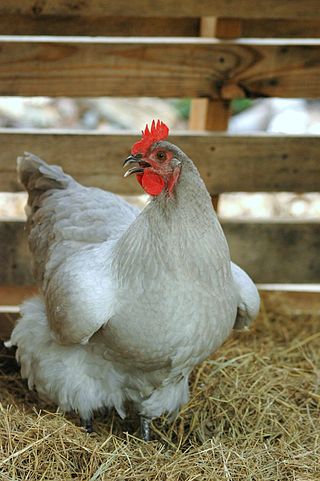
Lavender or self-blue refers to a plumage color pattern in the chicken characterized by a uniform, pale bluish grey color across all feathers. The distinctive color is caused by the action of an autosomal recessive gene, commonly designated as "lav", which reduces the expression of eumelanin and phaeomelanin so that black areas of the plumage appear pale grey instead, and red areas appear a pale buff.
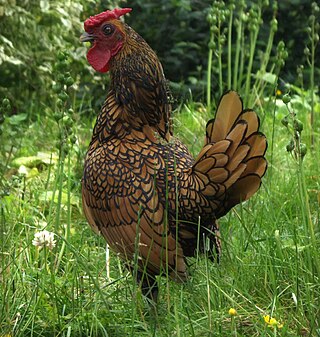
Hen feathering in cocks is the occurrence of a genetically conditioned character in domestic fowl. Males with this condition develop a female-type plumage, although otherwise look and respond as virile males.

Solid black plumage color refers to a plumage pattern in chickens characterized by a uniform, black color across all feathers. There are chicken breeds where the typical plumage color is black, such as Australorp, Sumatra, White-Faced Black Spanish, Jersey Giant and others. And there are many other breeds having different color varieties, which also have an extended black variety, such as Leghorn, Minorca, Wyandotte, Orpington, Langshan and others.

In poultry standards, solid white is coloration of plumage in chickens characterized by a uniform pure white color across all feathers, which is not generally associated with depigmentation in any other part of the body.
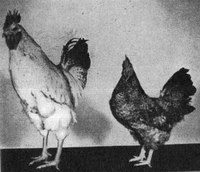
Dwarfism in chickens is an inherited condition found in chickens consisting of a significant delayed growth, resulting in adult individuals with a distinctive small size in comparison with normal specimens of the same breed or population.

The Frizzle is a breed of chicken with characteristic curled or frizzled plumage. While the frizzle gene can be seen in many breeds, such as the Pekin and Polish, the Frizzle is recognised as a distinct breed in a number of European countries and Australia. In the United States frizzled chickens are not considered a breed, and at shows are judged by the standards of the breed they belong to.

Chick sexing is the method of distinguishing the sex of chickens and other hatchlings, usually by a trained person called a chick sexer or chicken sexer. Chicken sexing is practiced mostly by large commercial hatcheries to separate female chicks or "pullets" from the males or "cockerels". The females and a limited number of males kept for meat production are then put on different feeding programs appropriate for their commercial roles.
Sex-linked barring is a plumage pattern on individual feathers in chickens, which is characterized by alternating pigmented and apigmented bars. The pigmented bar can either contain red pigment (phaeomelanin) or black pigment (eumelanin) whereas the apigmented bar is always white. The locus is therefore often referred to as an ‘eumelanin diluter’ or ‘melanin disruptor’. Typical sex-linked barred breeds include the Barred Plymouth Rock, Delaware, Old English Crele Games as well as Coucou de Renne.

Auto-sexing breeds of poultry are those in which the sex of newly-hatched chicks can be determined from the colour and markings of the down. Some breeds of chicken, of goose and of domestic pigeon have this characteristic. The idea of such a breed is due to Reginald Punnett, who created the first auto-sexing chicken breed, the Cambar, at the Genetical Institute in Cambridge in 1928.
Prelux are commercial chicken crossbreeds of the Slovenian origin, that are being sold under the eponymous trademark by the Biotechnical Faculty of University of Ljubljana. The name is an abbreviation for the Slovenian phrase prevojski luxuriranci, with a word luxuriranci referring to luxuriance (heterosis) or outbreeding enhancement of hybrid offspring, and adjective prevojski referring to the Slovenian settlement Prevoje, where selective breeding was once performed. This name was given to quality layer hens, that are being obtained by crossbreeding three Slovenian traditional breeds of layer hens; Slovenian Barred, Slovenian Brown and Slovenian Silver Hen. The most known and best-selling layer hens of the trademark Prelux are Prelux-Č, Prelux-G and Prelux-R. A part of the selection is also a meat type chicken (broiler), Prelux-BRO.



















